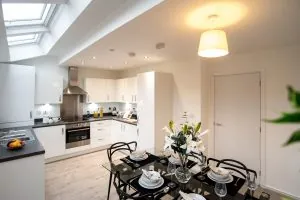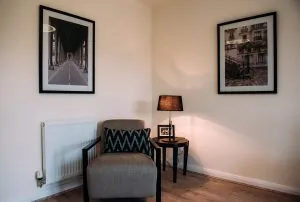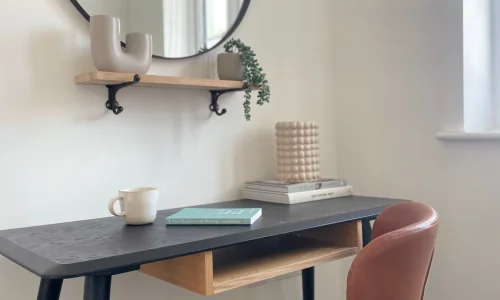6 Ways to Improve Mental Health Through Interior Design
In this article written by LOFT, there are some simple but effective tips for ensuring your interior design can have a positive impact on your mental health.

There’s nothing more important than your mental health, and modern life can really take its toll on the mind. A stressful job, a lack of “me time” and feeling isolated or lonely can all affect your wellbeing. In truth, many different factors play a role, which is why it’s important to find new ways to improve mental health wherever possible.
It’s estimated that Brits spend around 92% of their time indoors. While we don’t recommend spending that much time inside, we know it can be difficult to get outside for longer. Around eight hours a day is spent at work – whether in an office or at home – and the unpredictable British weather puts a lot of people off leaving the house, especially as we get into colder months. Covid-19 played its part as well with many people now choosing not to go out unless they have to.
Due to the amount of time spent inside, it’s important to consider how Interior Design can help improve mental health. The better we feel indoors, the better our wellbeing. There are many things that can be done to your interiors that will have a positive effect on your mind. Speaking with the LOFT Design team we’ve listed our top tips below.
1. Go with a Minimalist Design Style
Minimalist designs build on the concept of ‘less is more.’ Everything in your property must have a purpose, or you’ll simply create a space that has no rhyme or reason to it. There are five key elements to Minimalism that can help improve your mental health. They are:
- It creates a decluttered home
- A minimalist property is easy to maintain
- Every piece of furniture has a purpose
- Minimalism a timeless style
- It’s ideal if you’re furnishing on a budget
Once your home is decluttered, you start to appreciate the simplicity and beauty of the aesthetics that are in place. It puts a greater emphasis on what is there, rather than what isn’t, creating a calming and peaceful space. One of the Design teams favourite trends, this design trend requires a perfect balancing act, and it’s not easy to get right. But when it does work, it looks and feels effortless.

2. Introduce Elements of Nature
There’s a strong argument that people aren’t suited to being inside for so long. Modern humans evolved from beings that were significantly more in-tune with nature, and the longing for plantlife and natural Interior Design elements taps into the primitive aspects of our DNA.
Biophilic design is well known for its effect on improving our mood and wellbeing. Many studies have shown how plants help reduce stress levels and anxiety. Plantlife can even boost our cognitive ability, which is why the trend is proving popular in office spaces.
Small changes such as having a few houseplants or a window box installed can greatly improve mental health. They also add a touch of colour to a space and can help make an area appear larger when placed strategically.
 3. Let There be Light
3. Let There be Light
While we’re on the subject of nature, natural light is one of your best friends and you might not even realise it. Sunlight is great for making a space feel less confined and works wonders to improve your general mood. This is because sunlight is thought to increase the amount of serotonin your body releases, which makes a person feel calm and focused.
When designing a property, you need to find ways of introducing as much natural light as possible if you want to improve your mental health. This could mean utilising large windows, bifold doors, or skylights, and placing your sofa or desk in a place where you can catch the most light.
4. Think About the Colour Scheme
The psychology of colours is a significant aspect of Interior Design. Some shades can make us angrier, sadder, more depressed. On the other hand, other colours can make us happier, calmer and more thoughtful.
Muted colours such as tan and beige work in conjunction with biophilic designs to make a space feel brighter, more airy and relaxing. They also tend to work very well in a Minimalist setting, as the colour doesn’t distract the eye. Certain shades of green and blue can be added to bring a pop of colour to setting without taking anything away from the calming atmosphere you’re trying to achieve.
 5. Make Room for Company
5. Make Room for Company
Many people feel lonely or isolated, especially those who live alone. Lounges, kitchens and other communal areas are perfect spaces that can be opened up and made more inclusive. The right seating can help form close bonds, as people feel more inclined to speak with each other.
Creating space to chat – whether virtually or face to face – or simply be in the company of another person, can do wonders to lift your mood and reconnect you to those around you.
6. Remember to Add a Touch of Luxury
When all is said and done, you want to live in a nice home with tasteful decor. Old furniture that isn’t to your style or lacks comfort and quality can affect your mood. If you don’t like your interior, you’ll never really be happy at home because all you’ll think about is how much you want to change things. It’s a common mistake that people think luxury means a high price tag.

Reproduced with permission from LOFT Interiors. Read the original article here.



